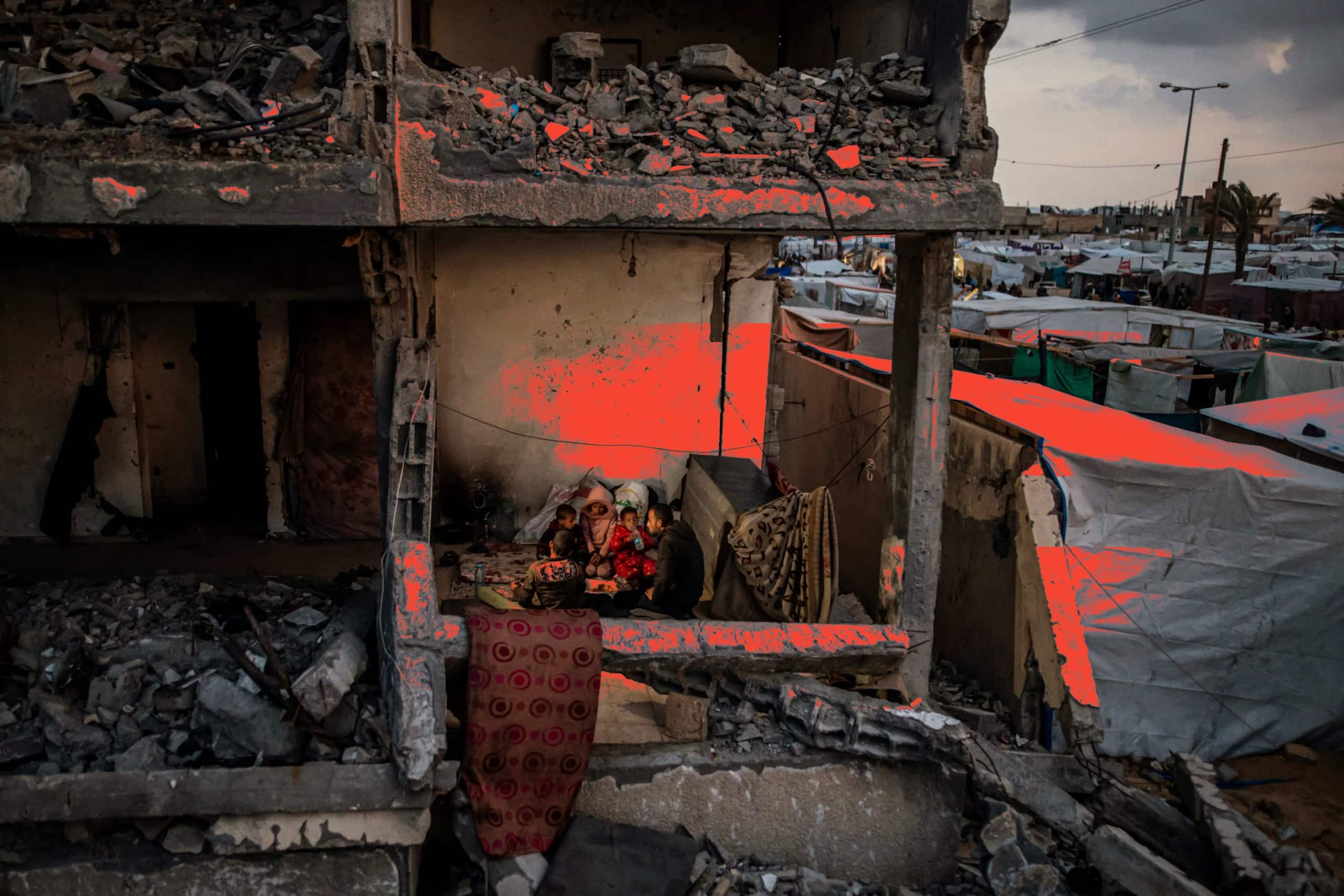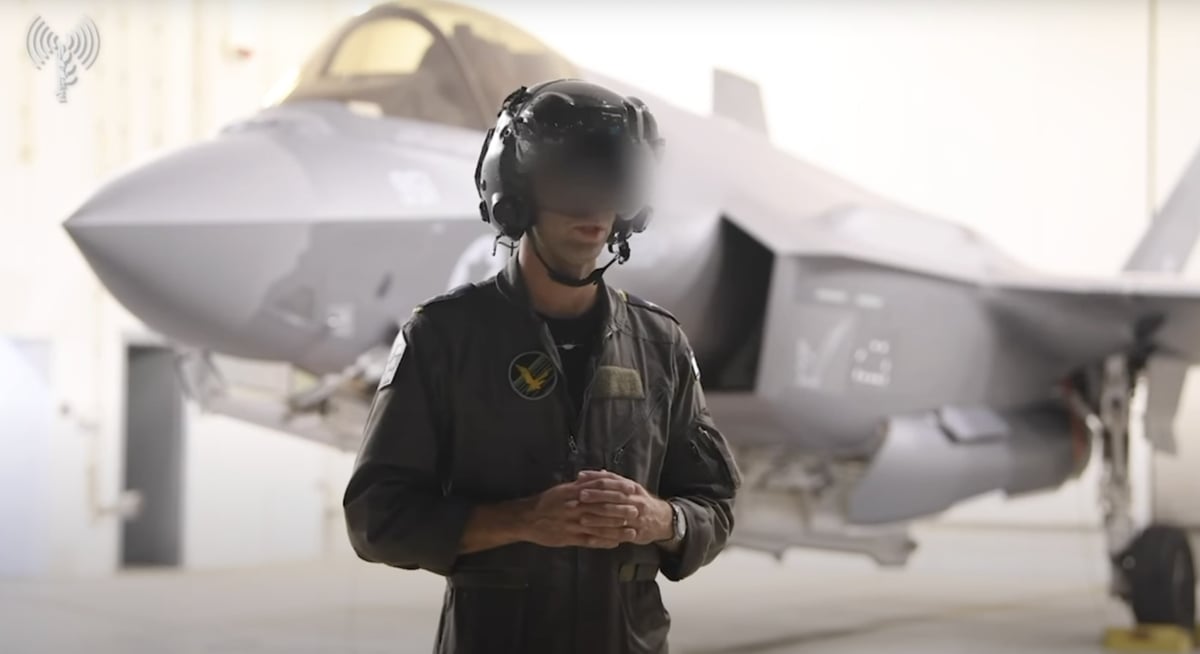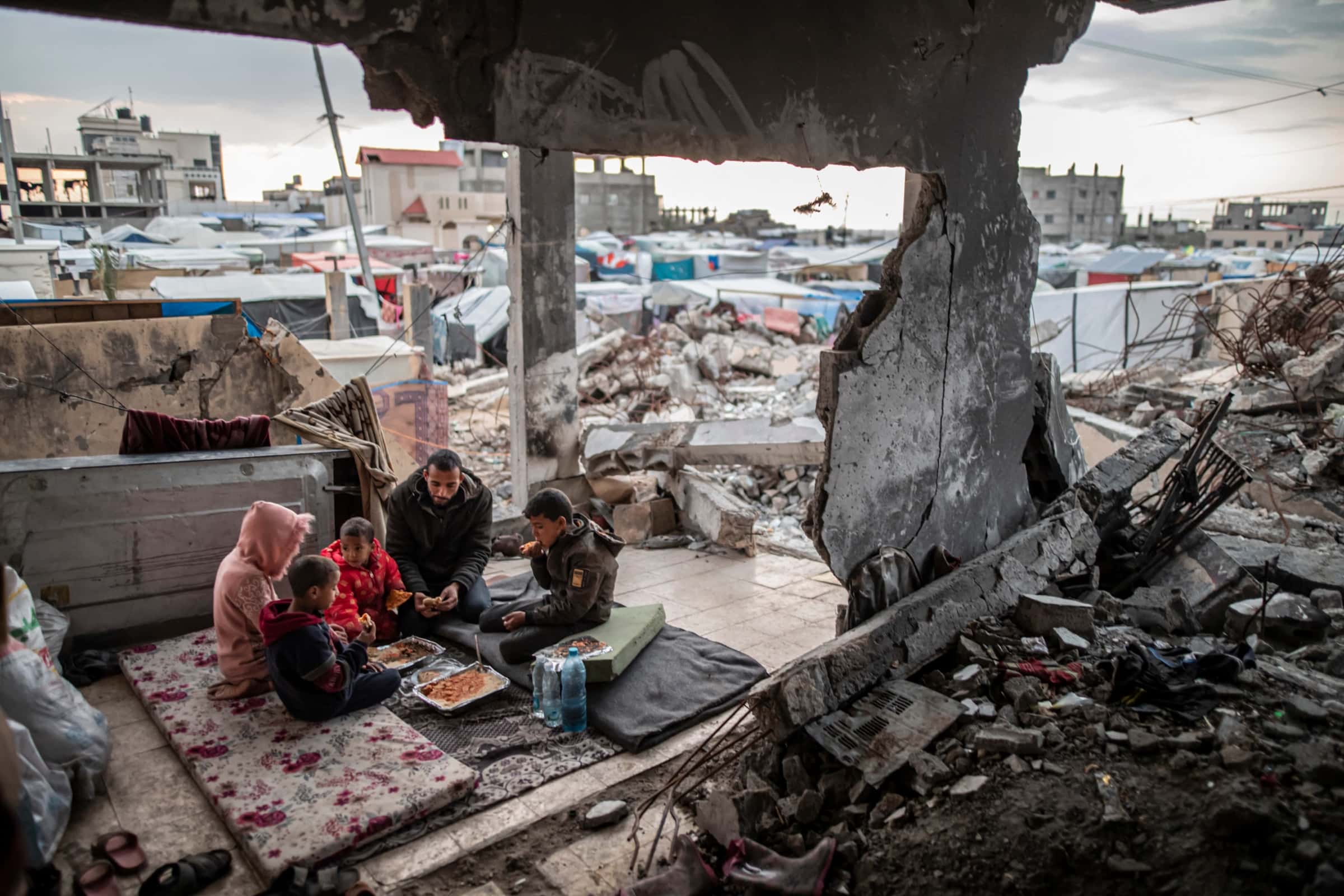

More than half of Gaza’s buildings have been destroyed and 13,000 children have been killed after the Israeli military has dropped thousands of bombs on the narrow strip of land that is home to more than two million people since the war began on 7 October 2023.
The Israel Defence Forces (IDF) has previously confirmed to Danwatch and Dagbladet Information that the F-35 aircraft are in operation in the Gaza Strip during the ongoing war against Hamas.
Now Danwatch, in collaboration with Information, can report that Israeli F-35 fighter jets with Danish military equipment are playing a central role in the massive bombings.
The aircraft, which are equipped with advanced military equipment from the Danish company Terma, are flying day and night, collecting data to identify bombing targets, dropping multi-ton bombs and causing massive destruction in Gaza.
This is according to a review of, among other things, Israeli TV interviews with F-35 pilots, US congressional hearings and the Israeli military’s social media, conducted by Danwatch and Information.
In a video released by the Israeli military on 2 November 2023, a pilot stands in front of an F-35 aircraft and on his uniform he wears the logo of the IDF’s Squadron 140, which is an F-35 squadron.
“We have carried out very significant attacks that seriously harm the Hamas regime in the Gaza Strip,” the F-35 pilot says in the video.
“In recent days, we have been working shoulder to shoulder with the ground forces, providing them with an air umbrella with enormous firepower,” the pilot continues in the video. He is the leader of Squadron 140 and in the video he is simply referred to as lieutenant-colonel ‘M’.
Military analyst Andrew Curtis, Associate Fellow at the Royal United Services Institute and former British Air Force officer, explains how the F-35 aircraft provides data that can be used to identify new military targets, among other things.
“The F-35 aircraft is not just a complex arms system, it is also a complex information system. In addition to bombing military targets with great precision, the aircraft collects intelligence that protects Israeli soldiers on the ground, while providing decision-makers in the IDF with data to identify new bombing targets,” says Andrew Curtis to Danwatch and Information.
The Danish-equipped F-35 fighter jets therefore play a central role in the war in a way that, for example, the Israeli F-16s cannot.
“It’s a paradigm shift, and something that Israel’s other fighter jets can’t match,” he says.
Interview
In a video released by the Israeli military on 2 November 2023, a pilot is interviewed in front of an F-35 aircraft and on his uniform he wears the logo of the IDF’s Squadron 140, “Golden Eagle”, which is an F-35 squadron.

The Danish-equipped fighter jets are also involved in Israel’s highly controversial use of so-called mega bombs in Gaza, one of the world’s most densely populated areas.
At just under 1,000 kg, the GBU-31 is one of the heaviest bombs in the Israeli military’s active arsenal, and according to the International Red Cross, the bomb is so powerful that it should not be used in urban areas.
In the first month of the Gaza war alone, Israel dropped more than 500 of the nearly one-ton GBU-31 bombs on the densely populated area, according to a CNN investigation. In comparison, the US-led coalition dropped only one multi-ton bomb during the entire war against Islamic State, according to the broadcaster.
The bombs can be lethal within a 300 meter radius and typically leave a 12 meter wide bomb crater. A report from a UN-appointed commission has previously warned that GBU-31 bombs “can rupture lungs and sinuses and tear off limbs hundreds of feet from the blast site” and “throw metal fragments a mile (1.6 kilometres) or more”.

According to an article in The Guardian, several arms experts estimate that two multi-ton bombs, most likely GBU-31s, were used in the attack on the Jabalia refugee camp on 31 October 2023, one of the deadliest bombings of the war.
Hundreds of people were killed and injured, and the UN High Commissioner for Human Rights has expressed “serious concerns that the attack was disproportionate and may constitute a war crime”.
Danwatch and Information’s review of statements from Israeli military sources, as well as images posted by the military on its social media sites, show that the Danish-equipped F-35 fighter jets are bombing with the controversial, multi-ton bombs.
As previously reported by Danwatch and Information, the F-35 aircraft carry the multi-ton GBU-31 bombs as standard equipment in their internal bomb bays.
No posts
The bombs can also be mounted under the wings of the F-35 aircraft in the so-called “air-to-ground” pylons, of which Danish Terma is part of the production. This allows the aircraft to carry several of the multi-ton bombs on a single mission.
And according to the Israeli military, it is an innovation in this war that the multi-ton so-called JDAM bombs have been dropped from the pylons of the F-35 aircraft and not just from the aircraft’s internal bomb bay. It provides a “significant improvement” in the aircraft’s attack capability, according to an article on the Israeli military’s website from January this year.
“Adir (the Israeli name for the F-35) aircraft used to carry arms inside the aircraft, but today they can carry a larger number and use multiple types of bombs, providing flexibility and adaptability for multiple missions in one flight,” the article states.
Interview
The laws of war allow for civilian casualties if there is proportionality between the military advantage of an attack and the number of civilians who lose their lives. In a TV interview, an Israeli F-35 pilot says that she has never before been subject to such lenient restrictions on “collateral damage”, i.e. how many civilian casualties are allowed, as is the case during this war. The interview has been translated as an appendix to a court case in the Netherlands about exports to the F-35 program.

“For me, it’s very clear what the definitions are. For each target I want to attack, I know exactly what collateral damage is allowed”.
Have the definitions of “collateral damage” changed after 7 October?
“Of course they have changed a lot. I’ve never in my life seen such a ‘light hand’ [trigger happy, translator’s note] but it’s also balanced and well thought through, and not everywhere”.
How can you throw bombs like that when there are (Israeli, ed.) hostages underneath?
“I am aware of that. We are aware of that. The whole air force is concerned about this because it’s important for us at all levels to know that we don’t hit the hostages.”
In a press briefing on 6 November 2023, the IDF announced that Chief of Staff Herzi Halevi visited Nevatim, the Israeli military base approximately 65 km from Gaza City where Israeli F-35 aircraft are based.
“The F-35 fighter jets strike terrorist targets and assist ground forces in very close attacks – as close as 200 meters away,” the press briefing states.
According to several media, IDF Chief of Staff Herzi Halevi said during the visit to Nevatim that the F-35s bomb Gaza with heavy ammunition.
“We have never done anything like this. With very heavy arms and a very good correlation between what the ground forces need and what the aircraft can do,” said Herzi Halevi at the Nevatim base.
That the Danish-equipped fighter jets throw multi-ton bombs is also confirmed by an F-35 pilot from the IDF’s 116 squadron.
In an interview with Israeli TV station Channel 13 on 13 January this year, the pilot, who is also Israel’s only female F-35 pilot, says that it takes only a few minutes from when an officer among the troops on the ground requests air support for the Air Force to provide it.
And this is true regardless if the assistance comes in the form of a drone, a helicopter or one of the “one-ton bombs” that she carries on her aircraft, the F-35 pilot explains in the interview.
At the same time, the pilot says that she has never before been subject to such lenient restrictions – such a “light hand” – in terms of civilian casualties as she has been during this war. However, she adds that she still sees the approach as balanced.
Several images and videos posted on social media by the Israeli Air Force IAF apparently show the GBU-31 bombs being prepared and loaded onto F35 aircraft.
Danwatch and Information have presented Terma with images of GBU-31 bombs in the pylons of Israeli F-35 aircraft. Head of Press Kasper Hyllested denies that it can be concluded that the pylons contain parts from Terma.
“We are neither today nor historically the sole supplier of these parts. Neither we, you nor others can determine whether our parts are on certain pylons without having access to inspect the individual pylons very thoroughly”, Kasper Hyllested writes.
Terma works closely with the American Marvin Group on the production of pylons for the F-35 aircraft. Danwatch and Information’s research confirm that there has previously been another supplier of air-to-ground pylons for the F-35 program.
According to an article from the analysis company Forecast International from March 2019, written by a former Terma employee, Turkish Aerospace Industries (TAI) in early 2019 produced 45% of the air-to-ground pylons for the F-35 aircraft. The rest was produced by Terma (45%) and Marvin Group (10%).
Following the decision in July 2019 to exclude Turkey from the F-35 program due to its procurement of Russian arms systems, TAI no longer supplies pylons for the F-35 aircraft.
Lockheed Martin, the main contractor for the F-35 aircraft, confirms this in an email to Danwatch and Information:
“In accordance with the guidance from US Department of Defence, there are currently no Turkish suppliers supporting the production of the F-35,” they write.
In other words, it cannot be concluded that the pylons that hold the bombs under the Israeli fighter jets contain parts from Terma’s Danish factories – although there is a certain probability that they do.
This is also confirmed by Terma’s head of press.
“That there is “a certain probability” that these are pylons with parts from Terma is principally correct, but it is impossible to say with certainty,” Kasper Hyllested writes in an email to Danwatch and Information.
Regardless, Terma provides advanced military equipment for all F-35 aircraft.

According to Terma’s own website, the company has more than 700 employees working to produce more than 80 different parts for the F-35 fighter jets.
In an interview with Avisen Danmark in 2022, CEO Jes Munk Hansen stated that “not one F-35 flies without parts from Terma”.
Lockheed Martin calls Denmark an “invaluable partner” in the production of the F-35 aircraft. Both Lockheed Martin and Terma confirm that there are Danish parts on all F-35 aircraft being produced.
“All F-35s contain components produced by Terma and Multicut, including pylons, advanced composites, radar components and horizontal tail fins,” a Lockheed Martin press officer wrote in an email to Danwatch and Information on March 14.
“It is correct that the F-35 aircraft that today leave the Lockheed Martin factory in Fort Worth, Texas, all contain parts produced by Terma. These may for example be composite parts,” Terma’s head of press writes in an email.
The importance of the F-35 aircraft to Israel’s warfare is also evidenced by a US Congressional hearing that took place on 12 December 2023.
Here, the director of the F-35 program, US lieutenant general Michael Schmidt, said that during the war, the Israeli military has optimised the time it takes from when the F-35s land at the Nevatim base to when they are back in the air with fresh supplies of fuel and bombs.
“I last spoke with the IDF Chief of Staff yesterday. We can learn a lot from them in terms of how quickly they get aircraft back in the air,” the program director told the attending legislators during the hearing.
Congressional hearing
During a hearing in the US Congress in December 2023, it was revealed that the F-35 program is learning “tremendously” from Israel’s use of the F-35 in Gaza and has added “capabilities” to the aircraft during the war.

Military analyst Andrew Curtis does not doubt that the Israeli military will use the Danish-equipped fighter jets as much as possible.
“The speed, i.e. the IDF refuelling the aircraft and loading it with new arms so quickly while briefing the pilot for a new mission, definitely implies that the IDF is doing what it can to keep the F-35 in the air around the clock,” says Andrew Curtis.
“I’m sure the Israeli military flies as many missions as possible with the F-35, as the F-35 is the best way for them to support troops on the ground in an urban area where you’re dropping bombs very close to your own soldiers and therefore need them to be accurate, but also need the intelligence it generates,” he says.
The military analyst also highlights the many capabilities of the F-35 aircraft.
“One of the advantages of the F-35 is that it can play many different roles. It can provide close air support to ground forces loaded with a large number of smaller bombs in the morning, and then in the afternoon it can fly with the big JDAM bombs (the multi-ton GBU bombs, ed.) as it supports Israeli ground forces in the search for the Hamas tunnel system. It can do both,” he says.
The F-35 program, of which Denmark is a member, also provides direct support to Israel in connection with the war in Gaza, including deliveries of spare parts for the Israeli F-35 aircraft.
This was also revealed in the US congressional hearing in December.

“Since early October, the F-35 program has been providing surge support to Israel,” said Michael Schmidt, director of the F-35 program.
He further explained that the “global maintenance infrastructure” of the F-35 program is currently being “tested through the current conflict in Israel” and that it has been instructive to “move parts around the world in support of a conflict”.
Michael Schmidt also said that the F-35 program has “added some capabilities” to the aircraft “in a very short time”.
The effort was praised by the chairman of the Congressional committee, Republican Rob Wittman, who highlighted how the F-35 program has acted “at breakneck speed to support our closest partner and ally in the Middle East, Israel”.
“They have done so by accelerating the F-35’s arms capabilities and increasing spare parts delivery rates in their fight against the atrocities committed by Hamas,” Wittman said.
Denmark is one of eight official partner countries in the F-35 program. In late January, Danish Minister of Defence Troels Lund Poulsen visited Lockheed Martin’s F-35 factories in the US to discuss Denmark’s role in the program.
Danwatch and Information have therefore asked the Ministry of Defence if and how Denmark, Danish officials, military personnel and companies have contributed to the F-35 program’s support for the Israeli warfare since 7 October.
However, the Ministry of Defence has not responded to the question by our deadline.
The Danish Minister for Foreign Affairs, Lars Løkke Rasmussen (M) has repeatedly stated that there is no basis for concluding that Israel has violated international law in Gaza.
And he has pointed out that the criticism of Denmark’s exports has not been based on concrete information about war crimes committed using the Danish-equipped F-35 fighter jets.
During a consultation in the Danish Parliament’s Foreign Affairs Committee in January this year, the Minister for Foreign Affairs said:
“I have to say – without sounding too harsh, but still – that the fact that there are F-35 aircraft in the air is not in itself something that may alter the outcome of this case”.
As Danwatch and Information have previously described, the Danish authorities have approved the export of military equipment for the F-35 program without assessing the risk of Israel using the equipment in connection with war crimes.
Since 2013, the F-35 program has been subject to a particularly lenient practice, which means that the Ministry of Foreign Affairs does not conduct a specific risk assessment according to the criteria in the UN and EU regulations, as is otherwise normal practice in other Danish military export cases.
This is a practice that legal experts have criticised as an illegal circumvention of international regulations, but which Minister for Foreign Affairs Lars Løkke Rasmussen has defended, among other things with reference to the fact that the United States is Denmark’s most important ally.
No posts
Danwatch and Information have shared the documentation presented in this article to the Danish Ministry of Foreign Affairs and the Ministry of Justice and asked whether the information will cause Danish authorities to reconsider whether it is in accordance with international law to continue the export to the F-35 program.
“We refer to the Minister’s previous statements on the matter,” reads the brief response from the Ministry of Foreign Affairs.
In a parliamentary response on 14 March, Minister for Foreign Affairs Lars Løkke Rasmussen writes that “he has noted” the Dutch High Court’s ruling on 12 February 2024. The case concerns the supply of parts for F-35 aircraft from a regional warehouse in the Netherlands directly to Israel. Likewise, he “has noted” the ruling of the ICJ on 26 January 2024 in South Africa’s case against Israel for violation of the Genocide Convention.
At the same time, “it is noted in relation to the F-35 cooperation that the consideration of Denmark’s foreign
and security policy interests continue to require that Denmark and Danish companies can enter into a close, binding cooperation with our closest allies, including the United States, and these countries’ companies with a view to strengthening Denmark’s strategic international and European supply chains and the development of defence materiel of importance to the security of both Denmark and Denmark’s allies.”
The reply states that the Ministry of Foreign Affairs “has temporarily encouraged the Danish National Police to consult the Ministry of Foreign Affairs regarding specific applications for the export of components for F-35 aircraft from Denmark”.
The Ministry of Justice refers to this parliamentary response in an email to Danwatch and Information:
“Since 15 February 2024, the Danish National Police has, in connection with the processing of specific cases, asked the Ministry of Foreign Affairs for an opinion on whether there are foreign and security policy conditions that mean that the application should not be granted in cases concerning equipment to be included in the F-35, where the recipient is specified as an EU, EFTA or NATO country and the end user is specified as unknown.”

At the same time, Lockheed Martin continues production of F-35 aircraft for Israel. Israel has ordered a total of 75 of the advanced F-35 aircraft and has so far received 39.
The Israeli military, IDF, declined to comment to Danwatch and Information on the role of the F-35 aircraft and the use of GBU-31 bombs during the war. Instead, a spokesperson refers to the IDF’s website, which states that the Israeli forces have “many measures to minimise civilian casualties” during its operations.
On the website, the IDF also writes that in their opinion, it is “first and foremost” Hamas that “bears responsibility for the widespread suffering it has caused by instigating the hostilities on 7 October and using civilians as human shields”.
Four organisations – Amnesty International Denmark, Oxfam Denmark, Mellemfolkeligt Samvirke and Palestinian Al-Haq – have recently announced that they will file a lawsuit against the Danish state for violation of the regulations in connection with Danish arms exports to Israel.